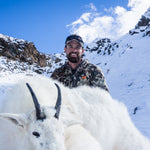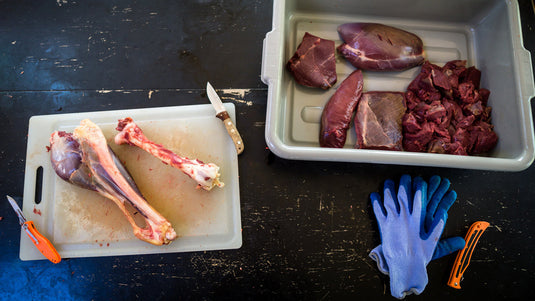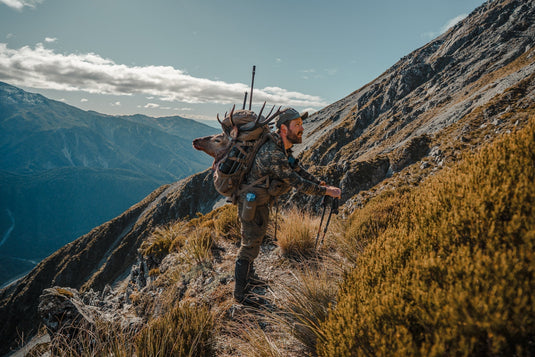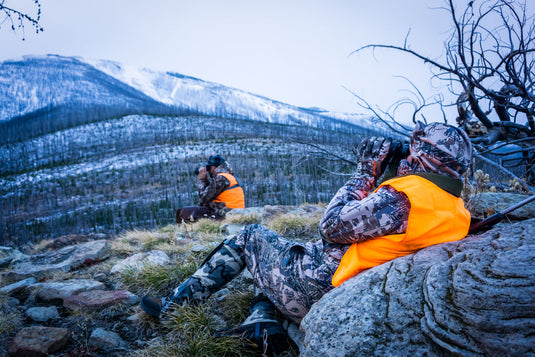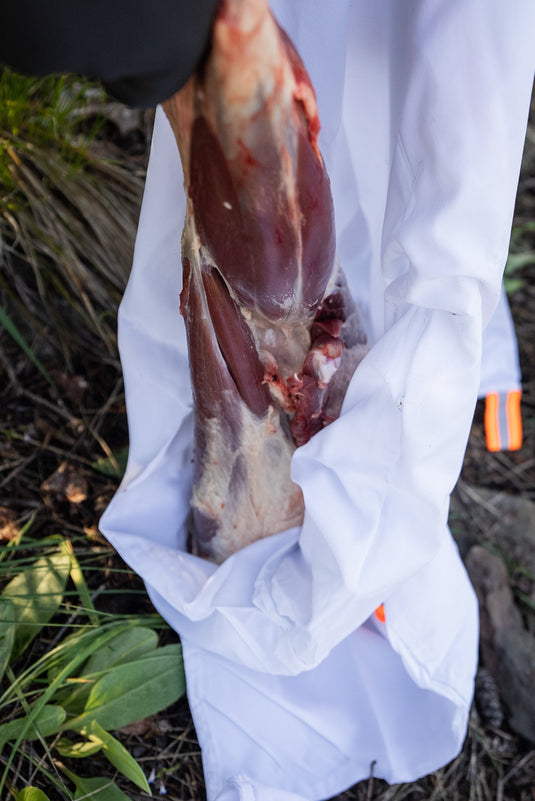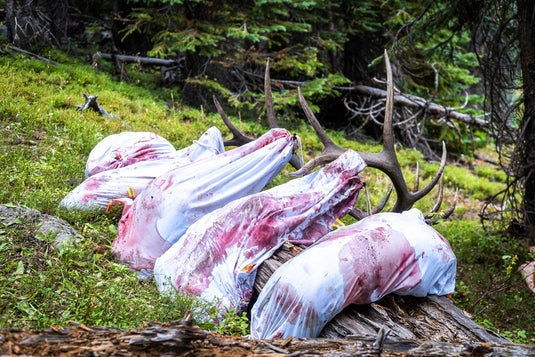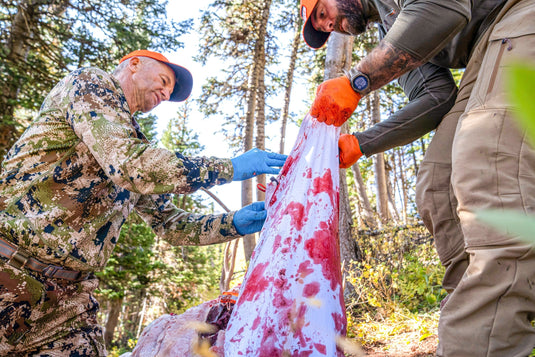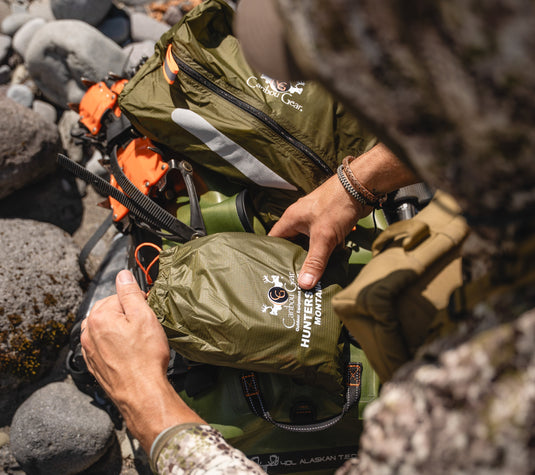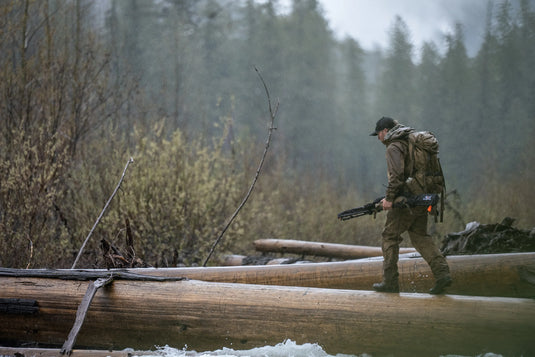When it comes to elk and mule deer hunting, snow is a blessing and a curse. On the actual hunting side of things, it’s a major advantage. When it’s cold and snowy, the game becomes more visible, they spend more time on their feet during daylight hours and it creates excellent opportunities for hunters. But on the other side of that coin, snow creates some headaches. Access to our hunting areas becomes more difficult. And freezing temperatures create uncomfortable camping conditions.
Personally, I pray for snow on my elk and mule deer hunts. It usually means fewer hunters to compete with out in the field, and better hunting conditions. With the right gear and preparations, a hunt and a camping trip out in the snow can be a ton of fun and very productive.
If you’re staring down the barrel of a snowstorm on an upcoming hunt, here are a few tips to help you feel prepared and ready to take advantage of the change in weather:
Access to Hunting Areas
Perhaps the most challenging part of a snowy hunt is accessing your hunt area. If you’re coming from out of state or a long way off, you may not even know which roads are passable and how far you’ll get. With this in mind, the best thing that you can do is to have flexible plans.
Before your hunt ever begins, have multiple options of places to hunt within your unit or wherever your license is valid. When e-scouting from home, creating plans A-Z is essential. And that’s not just because of weather. You might run into unexpected crowding, closed gates, or any number of factors that can derail plans.
But especially when you’re hunting western rifle seasons when snow is a likely scenario, it’s imperative that you have plans and then backup plans. That might include hunting off more well maintained roads. Or it might mean hunting at slightly lower elevations. Looks for places that you can hunt no matter what the conditions throw at you.
Additionally, come prepared with an equipped vehicle – as much as you are able. At the minimum, carry tire chains, a shovel, a tow strap and some basic recovery equipment that doesn’t cost a ton of money. I’ve put chains on my tires in order to access some excellent hunting areas in the snow. Then if you have it in your budget, you might also consider carrying adding a few extra items to your rig like quality off-road tires and recovery boards (check out MaxTrax).

Most importantly though, be cautious and be safe. Don’t over-play your hand. It’s better to stay safe and on the road than to push it too far and get stuck in an ugly situation. If necessary, there are often places worth hunting that can be accessed right from highways or Interstates. Especially if you’re willing to hike a few miles!
Setting Camp
Camping in the snow is miserable if you’re unprepared. If you’re well equipped it can be a ton of fun, not to mention the great hunting conditions.
The first consideration is whether you’ll be backpacking in, or setting a base camp where your vehicle is parked.
You might think, ‘Backpacking in the snow?’ And yes, backpacking in the snow is totally possible. With a tent like the Seek Outside Redcliff and one of their packable, titanium wood-burning stoves, you can have a toasty backcountry retreat. For some more tips on sleeping in the backcountry late in the season, check out this previous blog post.
No matter where you decide to camp, whether it’s front-country or backcountry, a quality sleep system, is critical. Before you set your tent, start by shoveling or kicking off any snow that’s already on the ground. The ground doesn’t need to be totally clear of snow. But try and remove the bulk of the snow in an area about a foot beyond the edges of your tent. This will provide a level surface and enough space to stake the tent down.
Next, set up your heat source. If you’re in a base camp at the truck, that might be a propane buddy heater or a wood-burning stove. If you’re in the backcountry, you can’t beat that Seek Outside tent with a titanium stove. Either way, make sure you have proper ventilation and get ready for those cold nighttime temperatures.

One of your next top priority considerations should be water. In a base camp, come prepared with a 5-gallon jug or however much you need for the size of your group and the duration of your hunt. In the backcountry, you’ll need a stream or other reliable water source that isn’t frozen over. Otherwise, you’ll be melting snow for water – which is doable, but slow, and will consume a lot of time and fuel. If there’s a reliable stream nearby, you can use a hatchet to break the surface ice and access the water if necessary. From there, a collapsible water jug is very handy for storing water in the backcountry.
Once you’ve collected water (and filtered it when necessary) place your water jugs inside the tent where they will keep from freezing overnight. In some extremely cold backcountry scenarios, we have even boiled water and then filled our water bottles before going to bed. Not only does this ensure you’ll have liquid water in the morning, it can be a nice addition to your sleeping bag at night.
Maintaining Camp
With snow and freezing temperatures, come a few extra camp chores. But later in the season, it’s getting dark earlier. So usually, there’s time after hunting to get things squared away.
Typically, cutting wood for a wood stove and collecting water are the two biggest factors – especially if you’re in a backcountry camp where creek water needs to be filtered. During the rifle seasons, you can expect to hunt until dark. Then, you might have a hike to get back to camp.
By the time I get back to camp, the first thing I like to take care of is wood for the stove in the tent. Once that’s done, it’s a bit easier to relax. Next, it’s time to check the water situation. Always make sure you have enough water for that night (dinner and drinking) plus enough water for the next day. The last thing you’ll want to do when you wake up in the sub-freezing pre-dawn darkness the next morning, is go fetch water. Get it done the night before.
Next, take the time to pack your lunch and your backpack for the next day’s hunt. Again, this is not something you’ll want to do in the morning. It’s much easier now while you’re up and moving and warm. Make sure everything is ready to go so that in the morning, you can crawl out of your sleeping bag, get dressed and start hiking right away to warm up.
Finally, with all those things finished, it’s time to fix a hot dinner and relax. Some of our favorite memories are on cold nights in the snowy backcountry, recounting the day’s adventures around the campfire.
Before you go to bed, be sure and stow your water jugs in the tent and fill your water bottles with boiling water again if necessary. Additionally, there are a few things that I like to keep with me in my sleeping bag to keep them from freezing. That includes my battery-powered devices like my phone, camera battery and headlamp. Plus, I put my water filter cartridge in the foot of my sleeping bag (allowing the cartridge to freeze can damage and ruin it).

The Hunting and Critical Gear
The actual hunting in the snow, that’s the fun part! Glass for tracks and look for animals on south-facing slopes, wind-blown ridges or wherever food is still accessible.
There are a few critical pieces of gear that can make your hunt in the snow more enjoyable. The first and perhaps most important is boots and socks. An insulated, waterproof boot like the Kenetrek Mountain Extreme 400 is a great choice. Along with a good merino wool sock, these will keep your feet dry and protected. If the temperatures are extremely cold, you may want an even warmer option. In these situations, we’d highly recommend the Kenetrek Grizzly Pac Boots.
Over your boots, always wear a pair of waterproof, breathable gaiters. These will keep snow from getting up over your boots and then wicking down into your socks. Whenever you’re hunting in the snow, gaiters are a must.
Next, a high quality set of waterproof, breathable rain gear is essential. Even when it’s not snowing, when there is snow on the ground, solid rain gear is important. Not only does it keep you dry, it blocks wind to help keep you warmer. Under your rain gear, pack a versatile layering system so that you can adjust layers based on temperatures and periods of stationary versus physical activity. For more tips on that topic, see this previous article on layering for late season hunts.
Finally, remember to carry an ultralight, packable tarp in your daypack while hunting. This will serve a couple of helpful purposes. You can use it as a shelter while glassing or waiting out a storm. And when you harvest an animal, you can use it as a dry surface to place the quarters and game bags. Even in cold weather, keeping the meat as dry as possible is important for quality meat care.
Getting Home Safely
One very important thing to remember on any late season hunt is not only how you’re going to access your hunting area – but how you’re going to get out safely. This means keeping a close eye on the forecast. If you’re hunting in an area without cell service, we highly recommend carrying a Garmin Inreach. This allows you to check for regular weather updates. And you can text someone back home, asking them to keep you apprised of the forecast.
In 2020 a few friends and I were hunting in a remote area of Colorado during a late rifle season. We were able to access the spot we wanted to hunt – however, we had to use tire chains to get there. Any more snow, and we could have risked getting stuck. Throughout the week, we kept a careful eye on the forecast. We were ready to pack up camp and bail out if there was any chance of snow. Fortunately, the forecast remained clear and we didn’t have to pack out early. But checking the weather every night was essential to make sure we stayed safe.
That’s also something to keep in mind as you’re driving in to an area. For example, don’t drive down a steep hill if you think there’s a chance your vehicle may not make it back up. Always pay attention to your surroundings, the road conditions and the weather. If you’re unsure, it’s always better to play it safe. It’s not worth having to leave your truck in the mountains until next spring.
Good luck and have fun on those snowy, late season hunts!

By Ryan McSparran
Ryan is an elk hunting guide based in Colorado, and is proud to be a part of the team at Caribou Gear.


